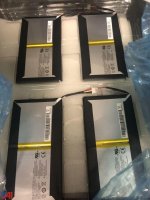From The image, it appears that each cell in the 10.4 Ah pack is individually wired to that connector.
Often, laptops and tablets have the BMS functions (balancing, LVC, HVC, Thermal monitoring, etc) all on the device, rather than the battery,..hence the multi wire connection from the individual cells in the battery.
So you either find the mating connector, or cut (very careful !) and discard that one.
But either way i do not suggest you attempt to separate the cells out from the packs..(high damage risk)
You will need to check the voltage of each individual cell and if necessary equalise them such that you can connect the cells in parallel.
Once all the +ve and all the -ve wires for the individual cells are connected you can treat it as one 10.4 Ah cell for testing.
Your 14S pack will need 14 of these “bricks” in series...and depending on how they test out, you will have to have multiple “bricks” in parallel at each of the 14S connections.
You have a lot of testing, and wiring connections to make since your chances of finding a suitable ready made harness is less than none !......and you do not want to risk a “lazy” or dud cell anywhere in that assembly of several dozen cells.




